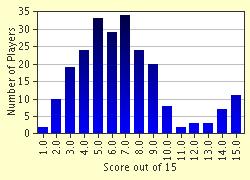Quiz Answer Key and Fun Facts
1. Leonardo da Vinci (1452-1519) was exasperated by a person called Salai. Who was he?
2. The purported mistress of Raphael (1483-1520) is said to have posed for some of his most famous paintings. What did her father do for a living?
3. Raphael's former assistant Giulio Romano (1499?-1546), a successful artist and architect in his own right, got into trouble for what?
4. The busy Michelangelo Buonarroti (1475-1564) is well known as a painter, sculptor, and architect. What other artistic activity did he pursue in his limited spare time?
5. Egocentric Florentine sculptor and jeweler Benvenuto Cellini (1500-1571) boasted of his military experience. In what event did he claim to have played a soldier's role?
6. Italian artist Ludovico Cigoli (1559-1613) was fascinated by a rapidly-developing field of 17th-century science and referred to it in a fresco. What was it?
7. The artist Caravaggio (1573-1610) had to flee Rome after he killed a man during an argument. What were they fighting about?
8. Flemish artist Peter Paul Rubens (1577-1640) had another career. What did he do besides paint?
9. Highly-original Baroque architect Francesco Borromini died how?
10. French artist Rosa Bonheur (1822-1899) was notorious for some unusual behavior. What did she like to do?
11. The great artist of the ballet and the racetrack, Edgar Degas (1834-1917), had an unusual background for an artist. What was it?
12. In 1878, James Whistler (1834-1903) sued art critic John Ruskin (1819-1900) for publishing libelous remarks about him and his painting, "Nocturne in Black and Gold: The Falling Rocket," and won. How much did the jury award him?
13. In 1848, John Ruskin married a woman named Euphemia (Effie) Gray, who successfully sought an annulment six years later. On what grounds did she claim that her marriage was invalid?
14. American architect and designer Frank Lloyd Wright (1869-1959) was involved in a tragedy in 1914. What was it?
15. Site artist Christo (b. 1935) was inadvertently responsible for someone's death. What happened?
Source: Author
lanfranco
This quiz was reviewed by FunTrivia editor
fringe before going online.
Any errors found in FunTrivia content are routinely corrected through our feedback system.

